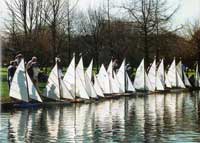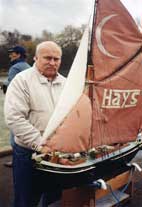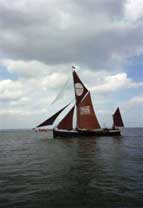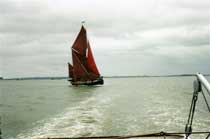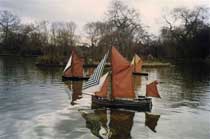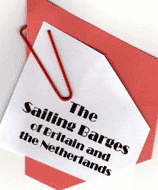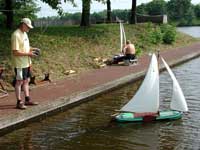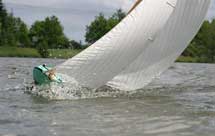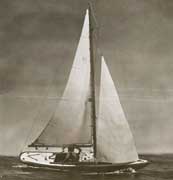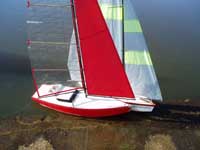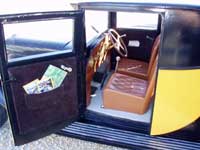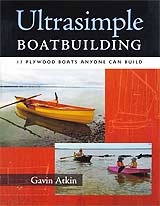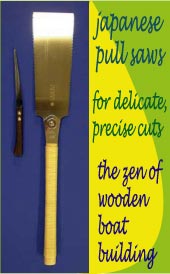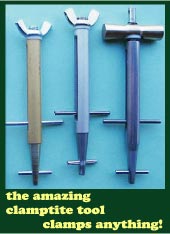Sailors for time left, the barges of the Thames and Netherlands, rolling with Rolex and a great Charters schooners
pretend shootout!
|

|
Model
yachts beckon all over the world - click thumbnails to enlarge
|
Some of us long retired model sailors may have, you
could say, `done our dash’ and we enjoy our
leisurely sailing (windling) as a quality-time period
where we are able to rekindle in a small way some
of the days of our faded youth. Armed with a model
sailboat built, bought or made for us by fellow sailor
friends who may have taken pity on our inaptitude
to even glue things straight, we are able to still
be sailors, or (become sailors) by virtue of a simple
windle even with the roughest of models on a quiet
pond, lake or stream for one of two days each week.
The best thing (I think anyway) is that we can relax
while letting our boyhood imagination that lurks inside
of us to absolutely run riot! We are `sailors’
for whatever time we may have left..

Hans Staal's camera magic - a beautiful image that portrays excitement and action.
|
“Now
truthfully dear, how much
did the model cost?”
Martin Davis (married with two kids and building
lots of power boat models) says (that) takes quite
a bit of money, so what modelers need to know is that`the
price of a model boat’ is:
- 1 The price you actually paid
- 2 The price you tell your wife you paid
- 3 The price she gets you to admit you paid and
- 4 The price you pay when she finds out what you
really paid!
(Borrowed’ from Martin’s excellent
website, Model
Boat Mayhem, which is well worth a
visit)
To many English ship modelers, the Thames Sailing
Barge (photos above) represents a vessel of great
interest and it is therefore no wonder that so many
are modeled and raced under the very well organized
race programme series run each year. The Thames barges
have been sailing, I think I read, since the end of
the 19th century, many still in use today for both
racing and pleasure. The barge was a type of commercial
sailing boat common on the River Thames in London.
Flat- bottomed and perfectly suitable to the often
shallow waters and narrow rivers of the Thames estuary.
Wooden hulled mainly with plumb ends, they also traded
further afield to the English south coast, and to
the north of England transporting mud, sand, bricks
coal grain and rubbish and needed only a crew of two.
They were usually between eighty and ninety feet long
with large hung rudders. The sailing models make for
a grand sight, particularly a `fair few’ fleet
of them sailing together and they are equally impressive
as the fullsize barges which are still sailed in barge
matches today.
Over in the Netherlands their Skutsje sailing barges
are somewhat different in design (photos below), and
according to friend and model shipwright/photographer,
Hans Staal there is a renewed interest in them as
RC sailing models. The ships were used for carrying
cargo such as manure and peat-soil to the farms along
the inland waterways of the Netherlands. Long and
with a flat bottom sp that they could sail on these
waterways most of them were built between 1800 and
1930, first in wood and in later years out of steel,
Each year they hold a big racing schedule over two
weeks for skutsjes in Friesland in the north of the
Netherlands
Hans who has provided me with these facts says that
in The Hague Model Boat Club they wanted to build,
sail and race model skutsjes and he built a prototype
and with a great deal of help from members a mould
was made and ten hulls produced. The prototype was
built of foam, the hulls from polyester and club member,
Wim Moonen was the first to complete a model. The
hull length is 1.40m and with an extra keel the models
sail well. To date five of the boats have been completed.
|
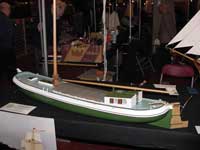
|
|
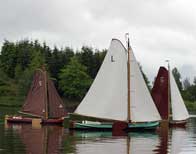
|
|
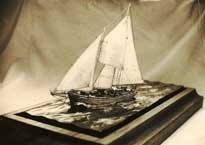
|
Indrek Lepson lives in Louisburg, North Carolina
in the USA and is a man who has built more models
than he can remember over a lengthy period of years.
Although from what I am led to believe these are mostly
display models, and many are very small (in many cases
a matter of a few inches in length) they are indeed
true works of art that are extensive in detail, and
I choose to show you a couple here above. Top left
is a model of Bacardi, a sloop designed by
Quincy Adams for the du Ponts. Shortly after they
got Indrek’s model, the boat shed along with
the boat were destroyed by fire and they had only
the model as a three dimensional reminder of her,
and the second one at right, a lovely schooner.
|
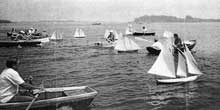
|
An anti-clobber protective measure this might be
described as but in reality it was all a bit of fun
offered by Auckland Ancient Mariner, Richard
Gross as a visual message to a fellow skipper with
a penchant for `inadvertant sideswiping’. His
Starlet was seen fitted with inflated balloons (`Nautical
Rumpy-Bumpy Boat Condoms’ I am told is what
they are called !) taped alongside its hulls. A quick
squeeze soon sorted one side out, the other side surviving
in order to be photographed It is a strange world
indeed is it not?
Whatever happened to the model schooner races that
used to be held at Cape Porpoise, Maine in
the USA I am prompted to ask? Mr Ed Hutchins who gave
me some details many years ago took the photograph
(above right) at this unique event where the non-RC
boats were followed and their courses altered by skippers
in rowboats. The event was started way back in the
1930’s by Ed’s father or grandfather,
both lobstermen, I seem to remember being told. Is
the event still held, perhaps someone can enlighten
me?
The Great Schooner Shootout!

|
It happened in July 2004 at a Maritime Festival held
on the Charleston, South Carolina waterfront in the
US when friend, Andrew Charters had two of his schooners
on display and where the spectators were treated to
an impromptu sailing by the William Fife designed Cicely (at left of the picture) and Andrew’s
other boat, Columbia. It wasn’t a race
really (Andrew says): “I was sailing Cicely and Elliot Dodds was sailing Columbia and
we just let them go as they went bow to bow beside
each other. Larry Cummins caught them on camera for
this wonderful photograph”.
 Rolex/Kurt Arrigo Photograph
Rolex/Kurt Arrigo Photograph |

Rolex/Carlo Borlenghi Photograph
|
When Rolex-sponsored yachting events take place in
various parts of the world (and they include the Rolex
Fastnet Race and the Rolex Sydney to Hobart), writers
can usually be guaranteed excellent, often really
stunning photographs free for editorial use. The photographers
they contract are among the most talented specialists
in marine photography, photographers like Carlo Borlenghi,
Daniel Forster, and now Kurt Arrigo who photographed
the Farr 40 Flash Gordon (above) in the Rolex
Settimana delle Bocche races held at Porto Servo in
Sardinia, Italy in June last year. I have shown Rolex/Carlo
Borlenghi photos in this column before, and in the
second photograph (top right) here is another one
that Borlenghi took of ABN AMRO ONE off Sydney
in 2006. Feel the spray, hear the power of whooshing
water as the boat cuts through!. (Let me set the record
straight: No I don’t wear a Rolex Yacht Master
II, just in case you are wondering, nor do I expect
one in the mail! I just think such great photographs
are inspirational and are worth sharing)
|

|
|
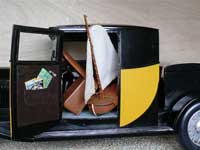
|
`Luffter’ is an important activity on the Auckland
windling scene! Above left (or is that `luft’?)
in the first of two photos by Richard Gross on a windless
day last July, two guys `cosy up’ for warmth.
And the photo below that, Roy Lake’s wonderful
wooden Bugatti just can’t carry a model yacht…
or can it?
To conclude… the `Medal of Great Bravery’
must go to Felix Hunter-Farklehumdinger Jr. in the
US Midwest for having named his Fairwind model yacht, Passing Foul Wind. |

